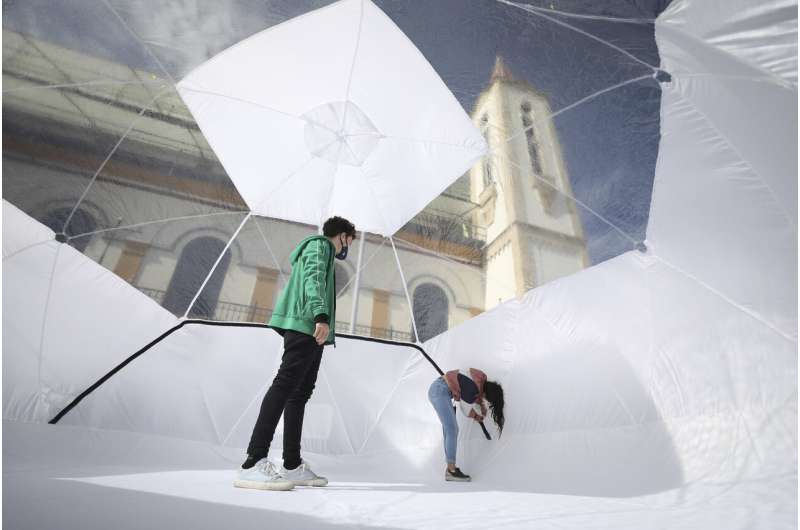Designers stand inside a Portable Epidemiological Insulation Unit during a media presentation, in Bogota, Colombia, Tuesday, Feb. 16, 2021. Colombia's La Salle University school of architecture designed the small polyhedral pneumatic geodesic domes which can be used to isolate and treat COVID-19 patients in areas where there are no nearby hospitals or where existing hospitals are overwhelmed with patients. (AP Photo/Fernando Vergara)
A shortage of hospital beds during the coronavirus pandemic has led architects in Colombia to design portable, inflatable chambers for coronavirus patients that can be placed in gyms or parking lots.
The domes—each 5 meters (16-feet) wide—can house two patients and are connected by inflatable hallways. Tubes help circulate air, which can cycle through 16 times an hour, according to the architects.
Developers around the world have devised other inflatable or pop-up structures to cope with the wave of COVID-19 patients, some for small wards, others for a few patients and some for individuals.
The version at Bogota's La Salle University includes eight, interconnected domes that can house 16 patients, and costs around $15,000,. according to researchers. Units can be added or subtracted as needed.
"We wanted to do something to respond to the health emergency the world is going through" said Alex Perez, an architecture professor who led the dome initiative. "At the start of the pandemic many health systems collapsed and patients were put in gyms or airport hangars, but the conditions in those places were not always the best."
Perez and his team on Tuesday displayed a set of domes built at a a local factory. It took less than an hour to set up and inflate them on a basketball court.
Designers walk through their Portable Epidemiological Insulation Unit during a media presentation, in Bogota, Colombia, Tuesday, Feb. 16, 2021. Colombia's La Salle University school of architecture designed the small polyhedral pneumatic geodesic domes which can be used to isolate and treat COVID-19 patients in areas where there are no nearby hospitals or where existing hospitals are overwhelmed with patients. (AP Photo/Fernando Vergara)
"These structures allow you to isolate coronavirus patients, but also keep an eye on them, because they're transparent," he said.
Three sets of domes have already been dispatched to cities in Colombia for use in vaccination campaigns. Perez said the university has made 12 sets so far, with funding from Colombia's Ministry of Science.
"This is just version 1.1" Perez said. "We want to improve them and see if there is a market for them among organizations that deal with emergencies."
© 2021 The Associated Press. All rights reserved. This material may not be published, broadcast, rewritten or redistributed without permission.

























